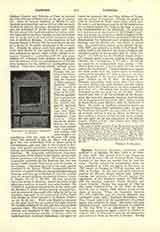

Caprara, GIOVANNI BAPTISTA, statesman and cardinal, b. at Bologna, May 29, 1733; d. at Paris, July 27, 1810. His parents were Count Francesco Raimondo Montecuccoli and Countess Maria Vittoria Caprara; it was from his mother that he took his name. Having entered the ecclesiastical state, he was appointed in 1758 vice-legate of Ravenna, in 1767 nuncio at Cologne, in 1775 at Lucerne, and in 1785 at Vienna. In this last and most important position he did not always defend with sufficient courage the interests of the Church against the aggressions of the Emperor Joseph II (1765-90), and the imperial ministers Prince Kaunitz and Count Cobenzl. During the summer of 1792 he was made Cardinal–Priest of the Title of Sant’ Onofrio, and in August; 1800, Bishop of Jesi in the Mark of Ancona. When the Concordat between Pius VII (1800-23) and the French Republic was concluded (July, 1801), Napoleon Bonaparte, then First Consul; asked for the appointment of a papal legate with residence in Paris. His choice fell upon Cardinal Caprara, undoubtedly because he expected in this way little or no opposition to his plans. Caprara was appointed legate a latere for France in August, 1801; he departed at once for his destination and arrived in Paris on the 4th of October. During the negotiations which followed concerning the execution of the Concordat he displayed too conciliatory a spirit in dealing with the ten constitutional bishops who were to be appointed to as many of the newly-established dioceses; in fact, he went contrary to specific instructions from Rome. However, persistent pressure exerted by Napoleon may be taken as an excuse for the legate’s conduct. Cardinal Caprara officiated at the solemn restoration of public worship in the cathedral of Notre-Dame on Easter Day (April 18, 1802), at which function the First Consul, the high officers of state, and the new ecclesiastical dignitaries assisted. At times the cardinal legate showed more strength in the interest of the Church; thus, in a letter written August 18, 1803, he protested most energetically against the Organic Articles added to the Concordat by the French Government.
In May, 1802, shortly after the above-mentioned solemnities, he was appointed Archbishop of Milan, and as such he blessed, on the 26th of May, 1805, the Iron Crown, which Napoleon placed on his own head in his new dignity of King of Italy. Otherwise Caprara retained his position as papal legate in France until his death, or rather until the imprisonment of Pope Pius VII in July, 1809. His declining health saved him from the embarrassment connected with the divorce and second marriage of Napoleon (April, 1810). In his last will his entire fortune was left to the hospital of Milan. In memory of all that was done in behalf of France he published the “Concordat et recueil des bulges et brefs de N. S. Pie VII sur les affaires de l’Eglise de France” (Paris, 1802). Cardinal Caprara was a man of simple and pure habits, zealous for religion and very charitable, but often inclined to yield to the imperious will of princes and ministers, a weakness which at times justified the reproaches of Pius VI (1775-99) and Pius VII.
FRANCIS J.

